Pressure Ulcers: Causes, Impact on Patients, and Preventive Measures
VerifiedAdded on 2022/09/15
|13
|3973
|15
Report
AI Summary
This report delves into the multifaceted issue of pressure ulcers, providing a comprehensive overview of their causes, including pressure, shear, friction, and immobility. It explores the impact of pressure ulcers on patients' lives, detailing the various stages and potential complications, such as infections, pain, and extended hospital stays. The report also examines the financial burden associated with pressure ulcers on healthcare systems. Furthermore, it highlights the importance of preventive strategies, such as patient education, staff training, and policy implementation, to mitigate the risk of pressure injuries. The report also discusses the significance of established standards of nursing practice and the role of policies in guiding healthcare professionals in providing competent care and effective management of pressure ulcers. The report concludes by emphasizing the need for continued research and awareness to reduce the prevalence and impact of this significant healthcare concern.
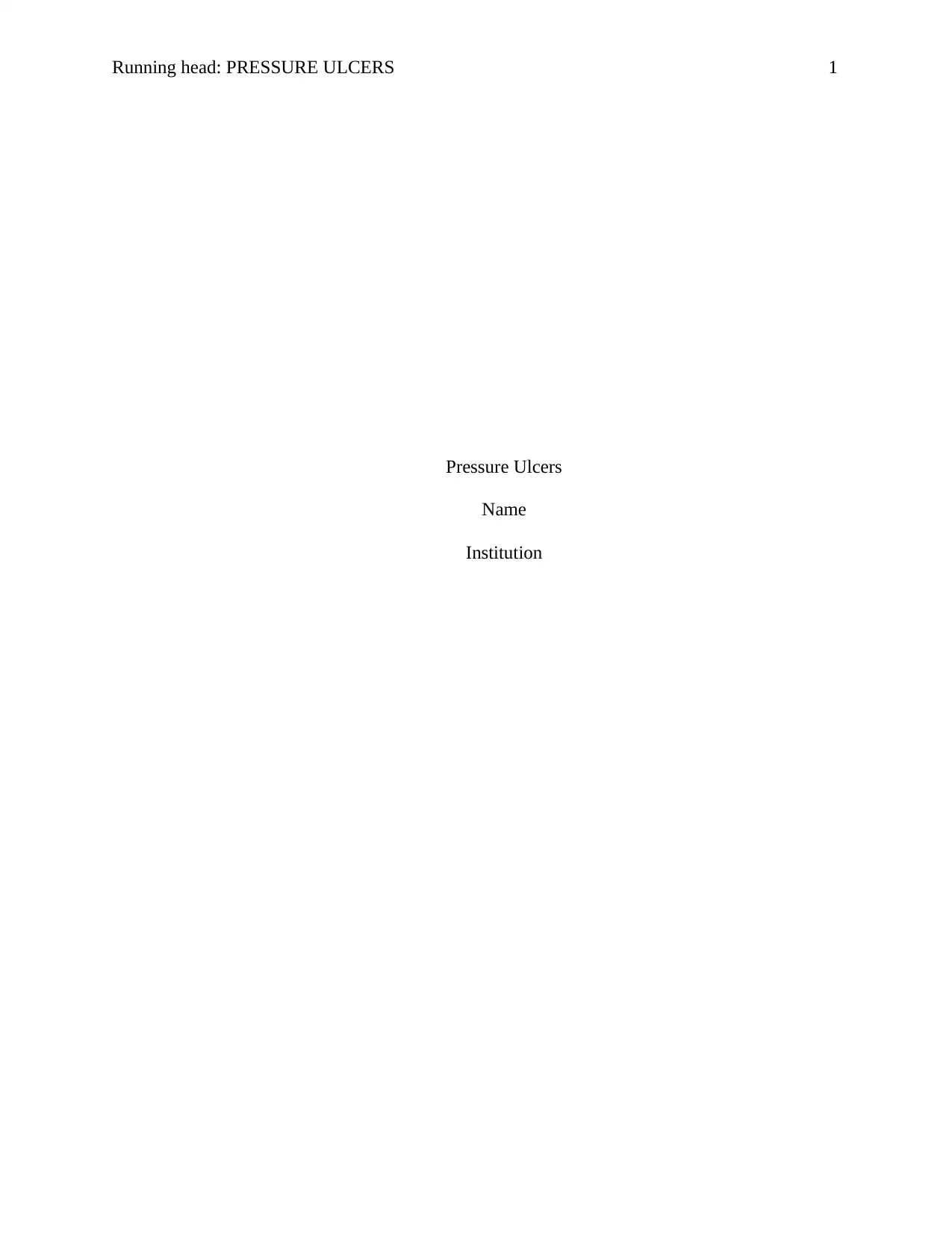
Running head: PRESSURE ULCERS 1
Pressure Ulcers
Name
Institution
Pressure Ulcers
Name
Institution
Paraphrase This Document
Need a fresh take? Get an instant paraphrase of this document with our AI Paraphraser
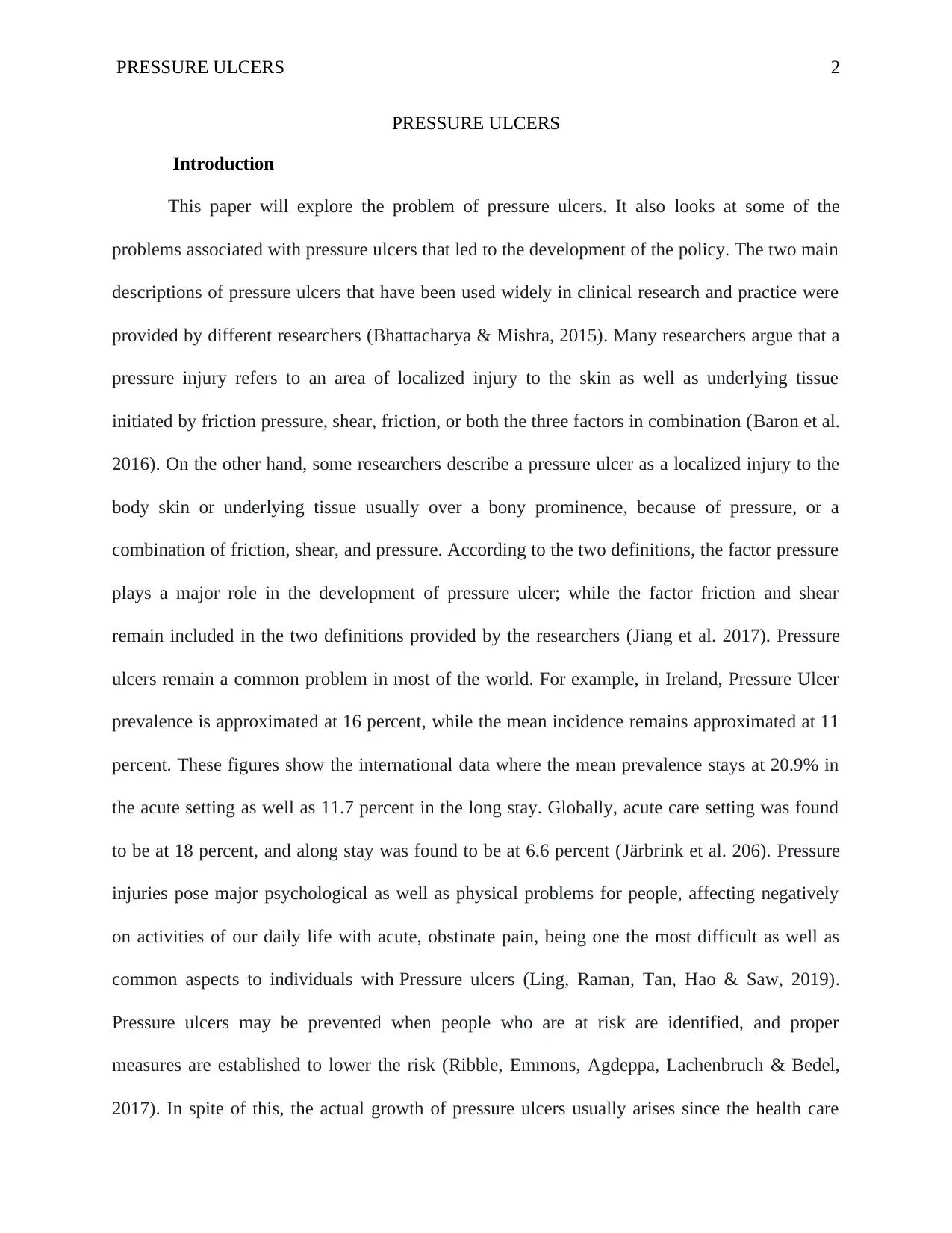
PRESSURE ULCERS 2
PRESSURE ULCERS
Introduction
This paper will explore the problem of pressure ulcers. It also looks at some of the
problems associated with pressure ulcers that led to the development of the policy. The two main
descriptions of pressure ulcers that have been used widely in clinical research and practice were
provided by different researchers (Bhattacharya & Mishra, 2015). Many researchers argue that a
pressure injury refers to an area of localized injury to the skin as well as underlying tissue
initiated by friction pressure, shear, friction, or both the three factors in combination (Baron et al.
2016). On the other hand, some researchers describe a pressure ulcer as a localized injury to the
body skin or underlying tissue usually over a bony prominence, because of pressure, or a
combination of friction, shear, and pressure. According to the two definitions, the factor pressure
plays a major role in the development of pressure ulcer; while the factor friction and shear
remain included in the two definitions provided by the researchers (Jiang et al. 2017). Pressure
ulcers remain a common problem in most of the world. For example, in Ireland, Pressure Ulcer
prevalence is approximated at 16 percent, while the mean incidence remains approximated at 11
percent. These figures show the international data where the mean prevalence stays at 20.9% in
the acute setting as well as 11.7 percent in the long stay. Globally, acute care setting was found
to be at 18 percent, and along stay was found to be at 6.6 percent (Järbrink et al. 206). Pressure
injuries pose major psychological as well as physical problems for people, affecting negatively
on activities of our daily life with acute, obstinate pain, being one the most difficult as well as
common aspects to individuals with Pressure ulcers (Ling, Raman, Tan, Hao & Saw, 2019).
Pressure ulcers may be prevented when people who are at risk are identified, and proper
measures are established to lower the risk (Ribble, Emmons, Agdeppa, Lachenbruch & Bedel,
2017). In spite of this, the actual growth of pressure ulcers usually arises since the health care
PRESSURE ULCERS
Introduction
This paper will explore the problem of pressure ulcers. It also looks at some of the
problems associated with pressure ulcers that led to the development of the policy. The two main
descriptions of pressure ulcers that have been used widely in clinical research and practice were
provided by different researchers (Bhattacharya & Mishra, 2015). Many researchers argue that a
pressure injury refers to an area of localized injury to the skin as well as underlying tissue
initiated by friction pressure, shear, friction, or both the three factors in combination (Baron et al.
2016). On the other hand, some researchers describe a pressure ulcer as a localized injury to the
body skin or underlying tissue usually over a bony prominence, because of pressure, or a
combination of friction, shear, and pressure. According to the two definitions, the factor pressure
plays a major role in the development of pressure ulcer; while the factor friction and shear
remain included in the two definitions provided by the researchers (Jiang et al. 2017). Pressure
ulcers remain a common problem in most of the world. For example, in Ireland, Pressure Ulcer
prevalence is approximated at 16 percent, while the mean incidence remains approximated at 11
percent. These figures show the international data where the mean prevalence stays at 20.9% in
the acute setting as well as 11.7 percent in the long stay. Globally, acute care setting was found
to be at 18 percent, and along stay was found to be at 6.6 percent (Järbrink et al. 206). Pressure
injuries pose major psychological as well as physical problems for people, affecting negatively
on activities of our daily life with acute, obstinate pain, being one the most difficult as well as
common aspects to individuals with Pressure ulcers (Ling, Raman, Tan, Hao & Saw, 2019).
Pressure ulcers may be prevented when people who are at risk are identified, and proper
measures are established to lower the risk (Ribble, Emmons, Agdeppa, Lachenbruch & Bedel,
2017). In spite of this, the actual growth of pressure ulcers usually arises since the health care
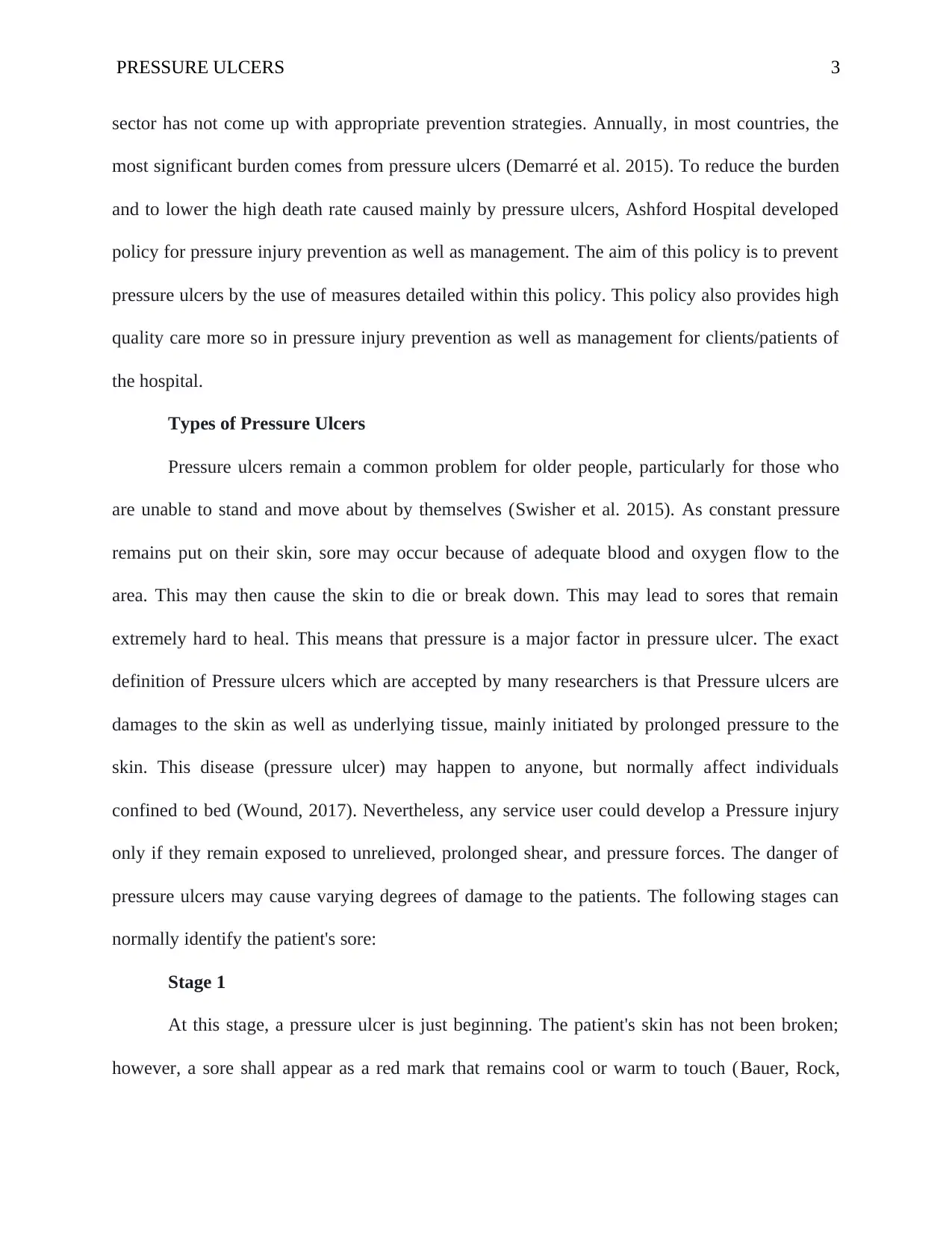
PRESSURE ULCERS 3
sector has not come up with appropriate prevention strategies. Annually, in most countries, the
most significant burden comes from pressure ulcers (Demarré et al. 2015). To reduce the burden
and to lower the high death rate caused mainly by pressure ulcers, Ashford Hospital developed
policy for pressure injury prevention as well as management. The aim of this policy is to prevent
pressure ulcers by the use of measures detailed within this policy. This policy also provides high
quality care more so in pressure injury prevention as well as management for clients/patients of
the hospital.
Types of Pressure Ulcers
Pressure ulcers remain a common problem for older people, particularly for those who
are unable to stand and move about by themselves (Swisher et al. 2015). As constant pressure
remains put on their skin, sore may occur because of adequate blood and oxygen flow to the
area. This may then cause the skin to die or break down. This may lead to sores that remain
extremely hard to heal. This means that pressure is a major factor in pressure ulcer. The exact
definition of Pressure ulcers which are accepted by many researchers is that Pressure ulcers are
damages to the skin as well as underlying tissue, mainly initiated by prolonged pressure to the
skin. This disease (pressure ulcer) may happen to anyone, but normally affect individuals
confined to bed (Wound, 2017). Nevertheless, any service user could develop a Pressure injury
only if they remain exposed to unrelieved, prolonged shear, and pressure forces. The danger of
pressure ulcers may cause varying degrees of damage to the patients. The following stages can
normally identify the patient's sore:
Stage 1
At this stage, a pressure ulcer is just beginning. The patient's skin has not been broken;
however, a sore shall appear as a red mark that remains cool or warm to touch (Bauer, Rock,
sector has not come up with appropriate prevention strategies. Annually, in most countries, the
most significant burden comes from pressure ulcers (Demarré et al. 2015). To reduce the burden
and to lower the high death rate caused mainly by pressure ulcers, Ashford Hospital developed
policy for pressure injury prevention as well as management. The aim of this policy is to prevent
pressure ulcers by the use of measures detailed within this policy. This policy also provides high
quality care more so in pressure injury prevention as well as management for clients/patients of
the hospital.
Types of Pressure Ulcers
Pressure ulcers remain a common problem for older people, particularly for those who
are unable to stand and move about by themselves (Swisher et al. 2015). As constant pressure
remains put on their skin, sore may occur because of adequate blood and oxygen flow to the
area. This may then cause the skin to die or break down. This may lead to sores that remain
extremely hard to heal. This means that pressure is a major factor in pressure ulcer. The exact
definition of Pressure ulcers which are accepted by many researchers is that Pressure ulcers are
damages to the skin as well as underlying tissue, mainly initiated by prolonged pressure to the
skin. This disease (pressure ulcer) may happen to anyone, but normally affect individuals
confined to bed (Wound, 2017). Nevertheless, any service user could develop a Pressure injury
only if they remain exposed to unrelieved, prolonged shear, and pressure forces. The danger of
pressure ulcers may cause varying degrees of damage to the patients. The following stages can
normally identify the patient's sore:
Stage 1
At this stage, a pressure ulcer is just beginning. The patient's skin has not been broken;
however, a sore shall appear as a red mark that remains cool or warm to touch (Bauer, Rock,
⊘ This is a preview!⊘
Do you want full access?
Subscribe today to unlock all pages.

Trusted by 1+ million students worldwide
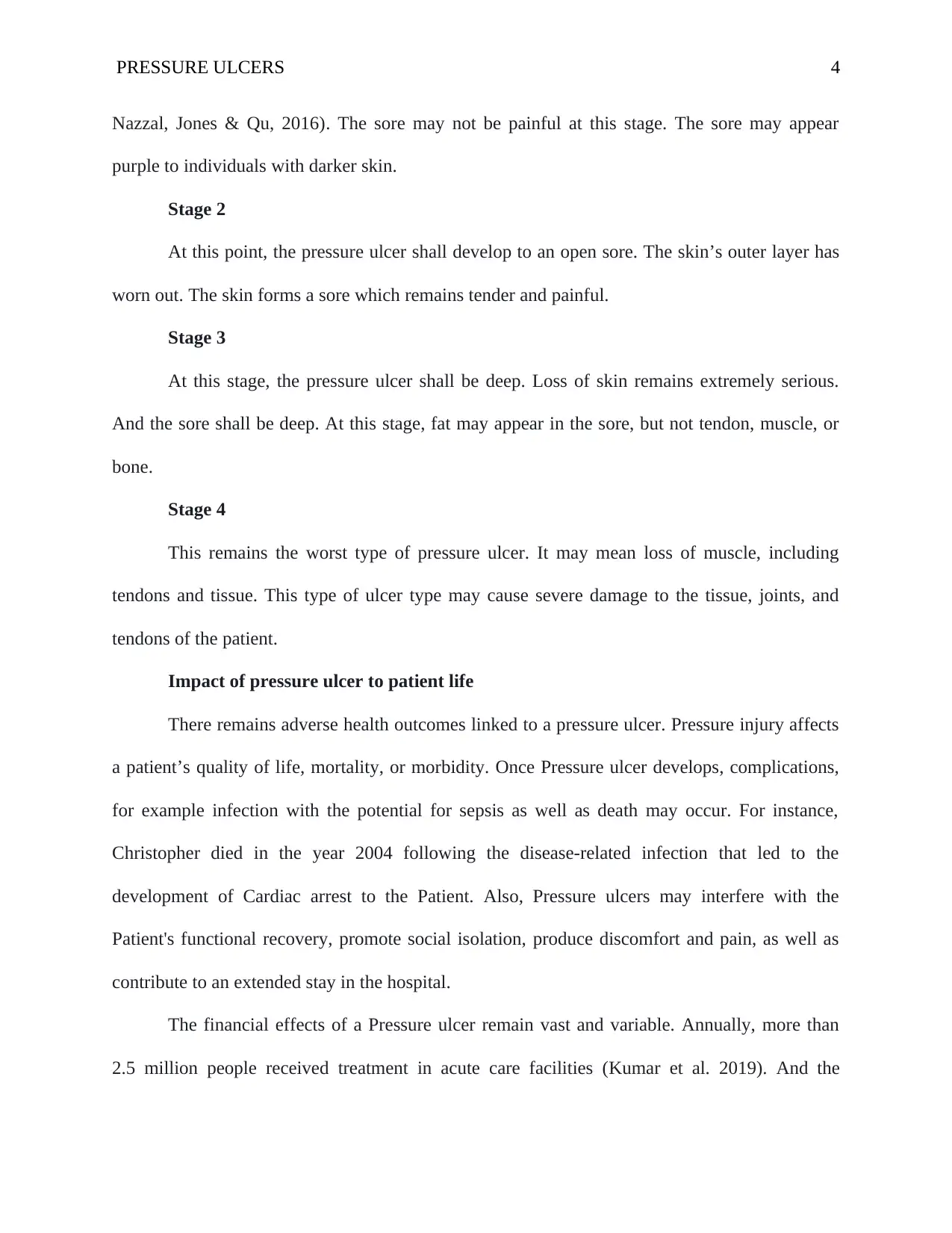
PRESSURE ULCERS 4
Nazzal, Jones & Qu, 2016). The sore may not be painful at this stage. The sore may appear
purple to individuals with darker skin.
Stage 2
At this point, the pressure ulcer shall develop to an open sore. The skin’s outer layer has
worn out. The skin forms a sore which remains tender and painful.
Stage 3
At this stage, the pressure ulcer shall be deep. Loss of skin remains extremely serious.
And the sore shall be deep. At this stage, fat may appear in the sore, but not tendon, muscle, or
bone.
Stage 4
This remains the worst type of pressure ulcer. It may mean loss of muscle, including
tendons and tissue. This type of ulcer type may cause severe damage to the tissue, joints, and
tendons of the patient.
Impact of pressure ulcer to patient life
There remains adverse health outcomes linked to a pressure ulcer. Pressure injury affects
a patient’s quality of life, mortality, or morbidity. Once Pressure ulcer develops, complications,
for example infection with the potential for sepsis as well as death may occur. For instance,
Christopher died in the year 2004 following the disease-related infection that led to the
development of Cardiac arrest to the Patient. Also, Pressure ulcers may interfere with the
Patient's functional recovery, promote social isolation, produce discomfort and pain, as well as
contribute to an extended stay in the hospital.
The financial effects of a Pressure ulcer remain vast and variable. Annually, more than
2.5 million people received treatment in acute care facilities (Kumar et al. 2019). And the
Nazzal, Jones & Qu, 2016). The sore may not be painful at this stage. The sore may appear
purple to individuals with darker skin.
Stage 2
At this point, the pressure ulcer shall develop to an open sore. The skin’s outer layer has
worn out. The skin forms a sore which remains tender and painful.
Stage 3
At this stage, the pressure ulcer shall be deep. Loss of skin remains extremely serious.
And the sore shall be deep. At this stage, fat may appear in the sore, but not tendon, muscle, or
bone.
Stage 4
This remains the worst type of pressure ulcer. It may mean loss of muscle, including
tendons and tissue. This type of ulcer type may cause severe damage to the tissue, joints, and
tendons of the patient.
Impact of pressure ulcer to patient life
There remains adverse health outcomes linked to a pressure ulcer. Pressure injury affects
a patient’s quality of life, mortality, or morbidity. Once Pressure ulcer develops, complications,
for example infection with the potential for sepsis as well as death may occur. For instance,
Christopher died in the year 2004 following the disease-related infection that led to the
development of Cardiac arrest to the Patient. Also, Pressure ulcers may interfere with the
Patient's functional recovery, promote social isolation, produce discomfort and pain, as well as
contribute to an extended stay in the hospital.
The financial effects of a Pressure ulcer remain vast and variable. Annually, more than
2.5 million people received treatment in acute care facilities (Kumar et al. 2019). And the
Paraphrase This Document
Need a fresh take? Get an instant paraphrase of this document with our AI Paraphraser
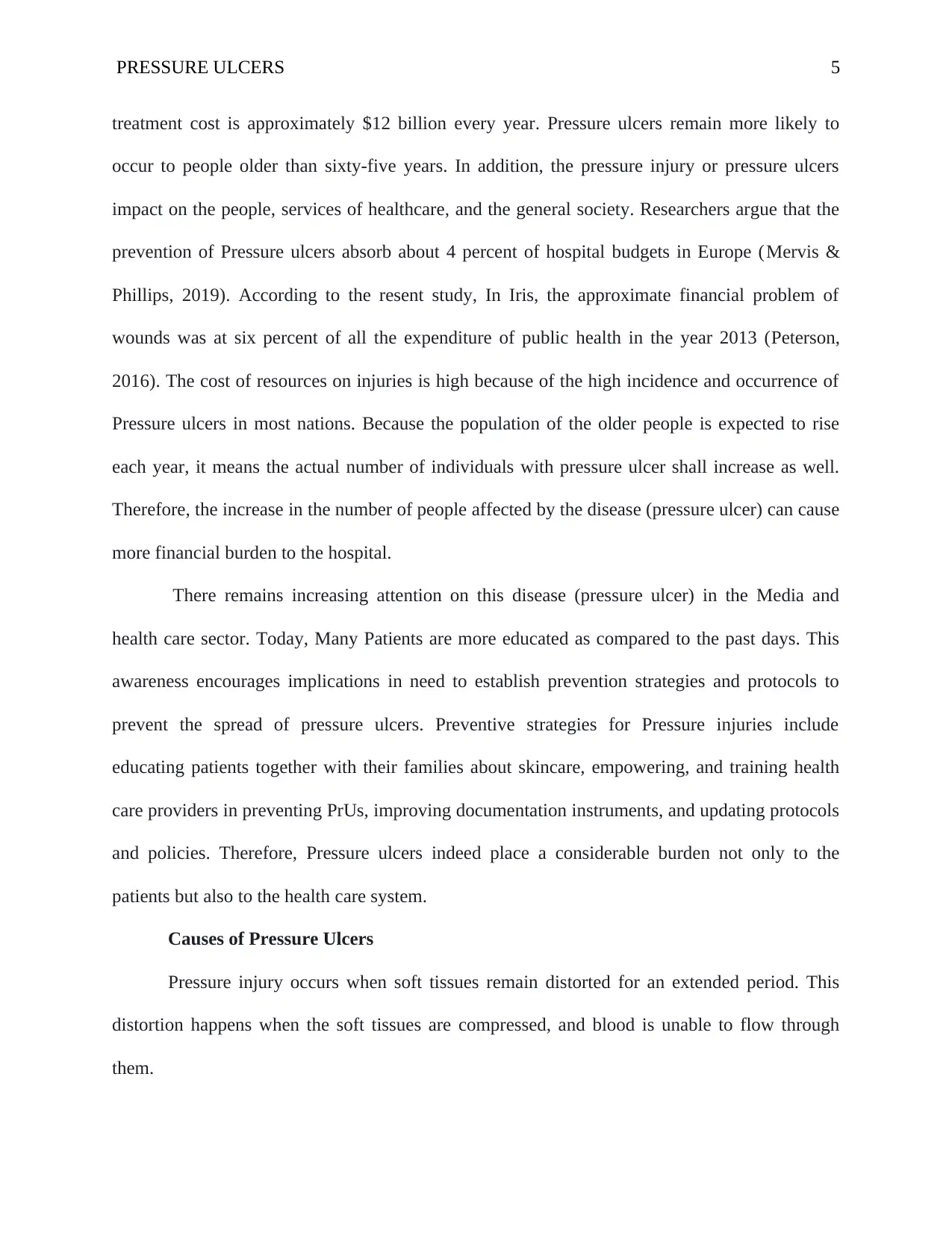
PRESSURE ULCERS 5
treatment cost is approximately $12 billion every year. Pressure ulcers remain more likely to
occur to people older than sixty-five years. In addition, the pressure injury or pressure ulcers
impact on the people, services of healthcare, and the general society. Researchers argue that the
prevention of Pressure ulcers absorb about 4 percent of hospital budgets in Europe (Mervis &
Phillips, 2019). According to the resent study, In Iris, the approximate financial problem of
wounds was at six percent of all the expenditure of public health in the year 2013 (Peterson,
2016). The cost of resources on injuries is high because of the high incidence and occurrence of
Pressure ulcers in most nations. Because the population of the older people is expected to rise
each year, it means the actual number of individuals with pressure ulcer shall increase as well.
Therefore, the increase in the number of people affected by the disease (pressure ulcer) can cause
more financial burden to the hospital.
There remains increasing attention on this disease (pressure ulcer) in the Media and
health care sector. Today, Many Patients are more educated as compared to the past days. This
awareness encourages implications in need to establish prevention strategies and protocols to
prevent the spread of pressure ulcers. Preventive strategies for Pressure injuries include
educating patients together with their families about skincare, empowering, and training health
care providers in preventing PrUs, improving documentation instruments, and updating protocols
and policies. Therefore, Pressure ulcers indeed place a considerable burden not only to the
patients but also to the health care system.
Causes of Pressure Ulcers
Pressure injury occurs when soft tissues remain distorted for an extended period. This
distortion happens when the soft tissues are compressed, and blood is unable to flow through
them.
treatment cost is approximately $12 billion every year. Pressure ulcers remain more likely to
occur to people older than sixty-five years. In addition, the pressure injury or pressure ulcers
impact on the people, services of healthcare, and the general society. Researchers argue that the
prevention of Pressure ulcers absorb about 4 percent of hospital budgets in Europe (Mervis &
Phillips, 2019). According to the resent study, In Iris, the approximate financial problem of
wounds was at six percent of all the expenditure of public health in the year 2013 (Peterson,
2016). The cost of resources on injuries is high because of the high incidence and occurrence of
Pressure ulcers in most nations. Because the population of the older people is expected to rise
each year, it means the actual number of individuals with pressure ulcer shall increase as well.
Therefore, the increase in the number of people affected by the disease (pressure ulcer) can cause
more financial burden to the hospital.
There remains increasing attention on this disease (pressure ulcer) in the Media and
health care sector. Today, Many Patients are more educated as compared to the past days. This
awareness encourages implications in need to establish prevention strategies and protocols to
prevent the spread of pressure ulcers. Preventive strategies for Pressure injuries include
educating patients together with their families about skincare, empowering, and training health
care providers in preventing PrUs, improving documentation instruments, and updating protocols
and policies. Therefore, Pressure ulcers indeed place a considerable burden not only to the
patients but also to the health care system.
Causes of Pressure Ulcers
Pressure injury occurs when soft tissues remain distorted for an extended period. This
distortion happens when the soft tissues are compressed, and blood is unable to flow through
them.
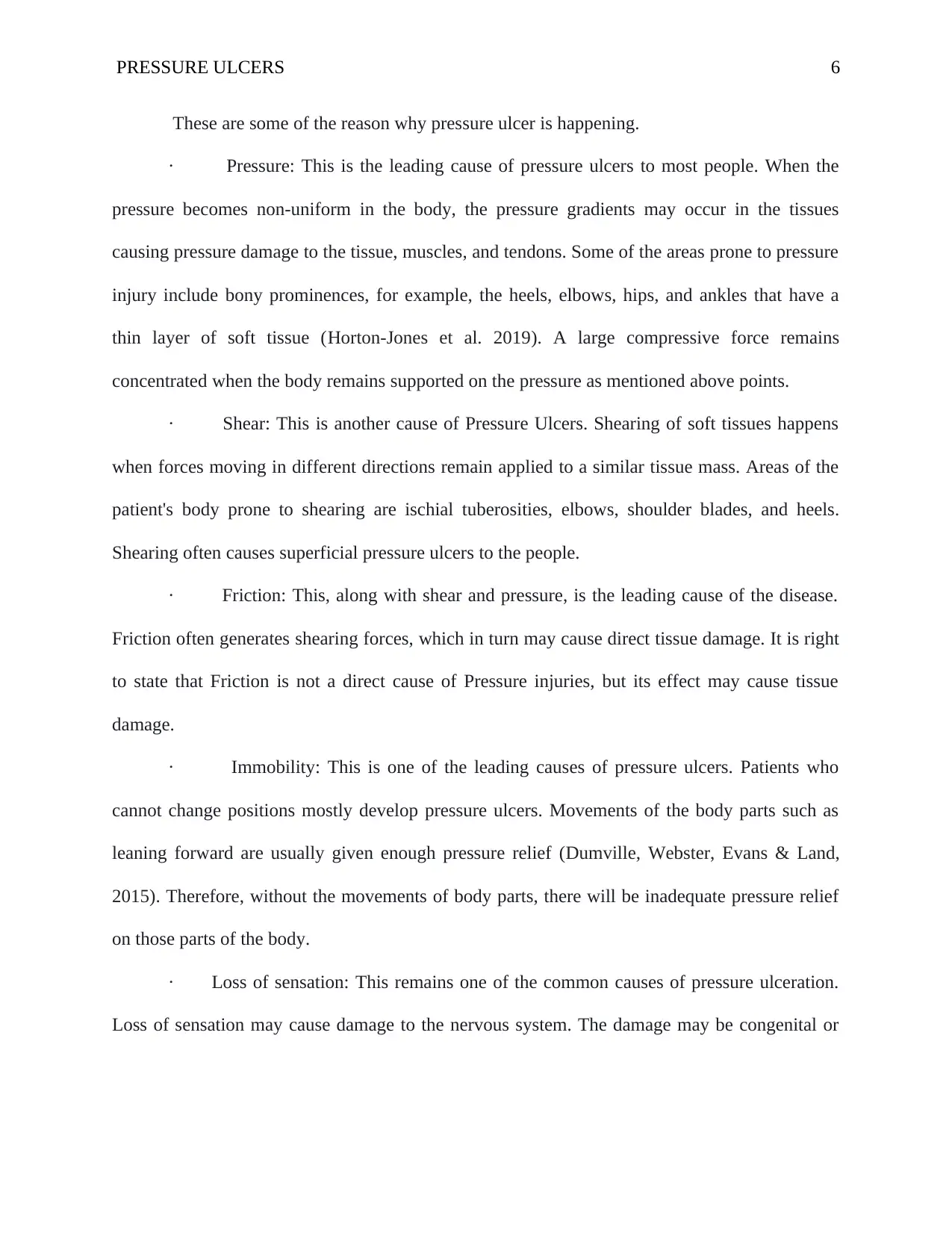
PRESSURE ULCERS 6
These are some of the reason why pressure ulcer is happening.
· Pressure: This is the leading cause of pressure ulcers to most people. When the
pressure becomes non-uniform in the body, the pressure gradients may occur in the tissues
causing pressure damage to the tissue, muscles, and tendons. Some of the areas prone to pressure
injury include bony prominences, for example, the heels, elbows, hips, and ankles that have a
thin layer of soft tissue (Horton-Jones et al. 2019). A large compressive force remains
concentrated when the body remains supported on the pressure as mentioned above points.
· Shear: This is another cause of Pressure Ulcers. Shearing of soft tissues happens
when forces moving in different directions remain applied to a similar tissue mass. Areas of the
patient's body prone to shearing are ischial tuberosities, elbows, shoulder blades, and heels.
Shearing often causes superficial pressure ulcers to the people.
· Friction: This, along with shear and pressure, is the leading cause of the disease.
Friction often generates shearing forces, which in turn may cause direct tissue damage. It is right
to state that Friction is not a direct cause of Pressure injuries, but its effect may cause tissue
damage.
· Immobility: This is one of the leading causes of pressure ulcers. Patients who
cannot change positions mostly develop pressure ulcers. Movements of the body parts such as
leaning forward are usually given enough pressure relief (Dumville, Webster, Evans & Land,
2015). Therefore, without the movements of body parts, there will be inadequate pressure relief
on those parts of the body.
· Loss of sensation: This remains one of the common causes of pressure ulceration.
Loss of sensation may cause damage to the nervous system. The damage may be congenital or
These are some of the reason why pressure ulcer is happening.
· Pressure: This is the leading cause of pressure ulcers to most people. When the
pressure becomes non-uniform in the body, the pressure gradients may occur in the tissues
causing pressure damage to the tissue, muscles, and tendons. Some of the areas prone to pressure
injury include bony prominences, for example, the heels, elbows, hips, and ankles that have a
thin layer of soft tissue (Horton-Jones et al. 2019). A large compressive force remains
concentrated when the body remains supported on the pressure as mentioned above points.
· Shear: This is another cause of Pressure Ulcers. Shearing of soft tissues happens
when forces moving in different directions remain applied to a similar tissue mass. Areas of the
patient's body prone to shearing are ischial tuberosities, elbows, shoulder blades, and heels.
Shearing often causes superficial pressure ulcers to the people.
· Friction: This, along with shear and pressure, is the leading cause of the disease.
Friction often generates shearing forces, which in turn may cause direct tissue damage. It is right
to state that Friction is not a direct cause of Pressure injuries, but its effect may cause tissue
damage.
· Immobility: This is one of the leading causes of pressure ulcers. Patients who
cannot change positions mostly develop pressure ulcers. Movements of the body parts such as
leaning forward are usually given enough pressure relief (Dumville, Webster, Evans & Land,
2015). Therefore, without the movements of body parts, there will be inadequate pressure relief
on those parts of the body.
· Loss of sensation: This remains one of the common causes of pressure ulceration.
Loss of sensation may cause damage to the nervous system. The damage may be congenital or
⊘ This is a preview!⊘
Do you want full access?
Subscribe today to unlock all pages.

Trusted by 1+ million students worldwide
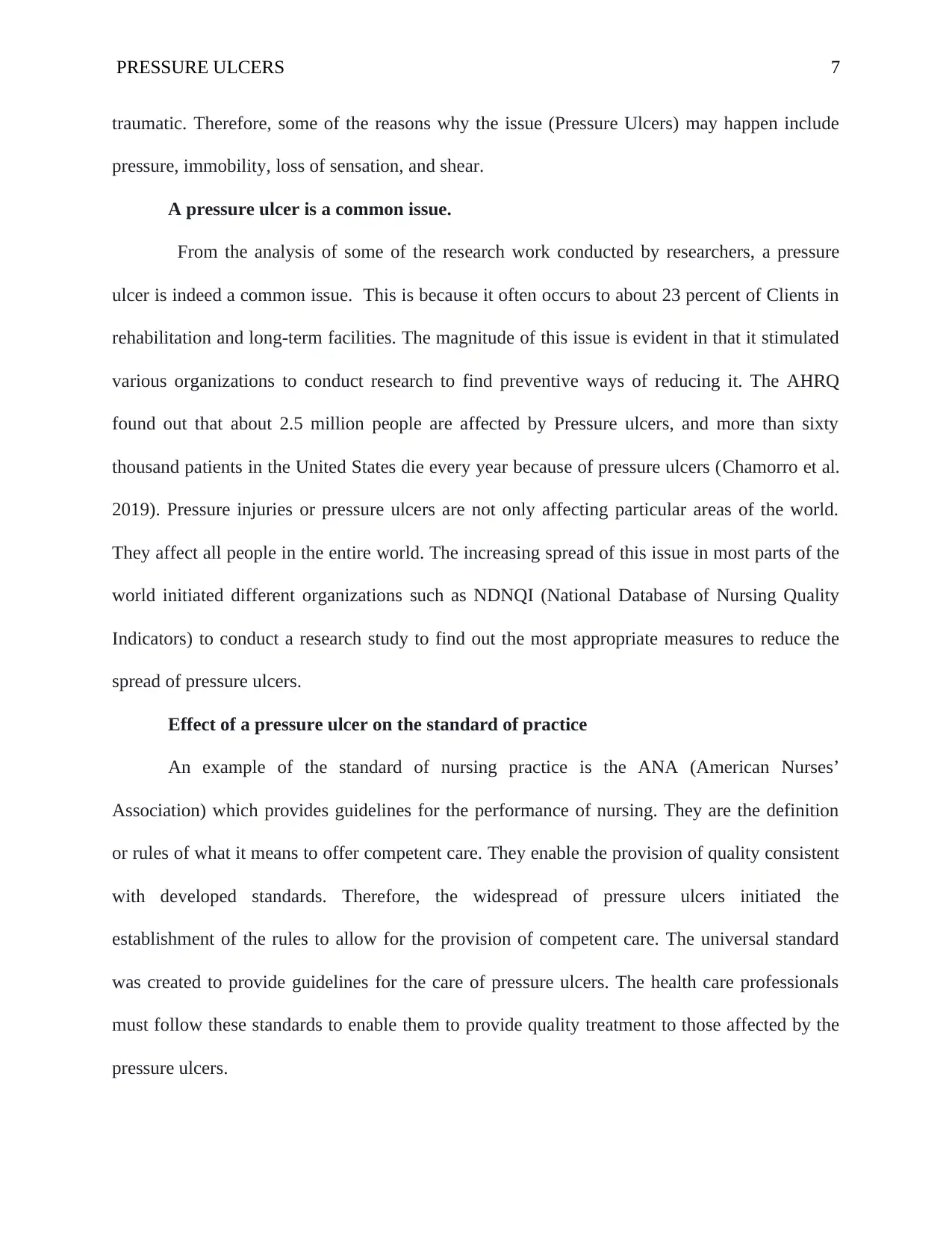
PRESSURE ULCERS 7
traumatic. Therefore, some of the reasons why the issue (Pressure Ulcers) may happen include
pressure, immobility, loss of sensation, and shear.
A pressure ulcer is a common issue.
From the analysis of some of the research work conducted by researchers, a pressure
ulcer is indeed a common issue. This is because it often occurs to about 23 percent of Clients in
rehabilitation and long-term facilities. The magnitude of this issue is evident in that it stimulated
various organizations to conduct research to find preventive ways of reducing it. The AHRQ
found out that about 2.5 million people are affected by Pressure ulcers, and more than sixty
thousand patients in the United States die every year because of pressure ulcers (Chamorro et al.
2019). Pressure injuries or pressure ulcers are not only affecting particular areas of the world.
They affect all people in the entire world. The increasing spread of this issue in most parts of the
world initiated different organizations such as NDNQI (National Database of Nursing Quality
Indicators) to conduct a research study to find out the most appropriate measures to reduce the
spread of pressure ulcers.
Effect of a pressure ulcer on the standard of practice
An example of the standard of nursing practice is the ANA (American Nurses’
Association) which provides guidelines for the performance of nursing. They are the definition
or rules of what it means to offer competent care. They enable the provision of quality consistent
with developed standards. Therefore, the widespread of pressure ulcers initiated the
establishment of the rules to allow for the provision of competent care. The universal standard
was created to provide guidelines for the care of pressure ulcers. The health care professionals
must follow these standards to enable them to provide quality treatment to those affected by the
pressure ulcers.
traumatic. Therefore, some of the reasons why the issue (Pressure Ulcers) may happen include
pressure, immobility, loss of sensation, and shear.
A pressure ulcer is a common issue.
From the analysis of some of the research work conducted by researchers, a pressure
ulcer is indeed a common issue. This is because it often occurs to about 23 percent of Clients in
rehabilitation and long-term facilities. The magnitude of this issue is evident in that it stimulated
various organizations to conduct research to find preventive ways of reducing it. The AHRQ
found out that about 2.5 million people are affected by Pressure ulcers, and more than sixty
thousand patients in the United States die every year because of pressure ulcers (Chamorro et al.
2019). Pressure injuries or pressure ulcers are not only affecting particular areas of the world.
They affect all people in the entire world. The increasing spread of this issue in most parts of the
world initiated different organizations such as NDNQI (National Database of Nursing Quality
Indicators) to conduct a research study to find out the most appropriate measures to reduce the
spread of pressure ulcers.
Effect of a pressure ulcer on the standard of practice
An example of the standard of nursing practice is the ANA (American Nurses’
Association) which provides guidelines for the performance of nursing. They are the definition
or rules of what it means to offer competent care. They enable the provision of quality consistent
with developed standards. Therefore, the widespread of pressure ulcers initiated the
establishment of the rules to allow for the provision of competent care. The universal standard
was created to provide guidelines for the care of pressure ulcers. The health care professionals
must follow these standards to enable them to provide quality treatment to those affected by the
pressure ulcers.
Paraphrase This Document
Need a fresh take? Get an instant paraphrase of this document with our AI Paraphraser
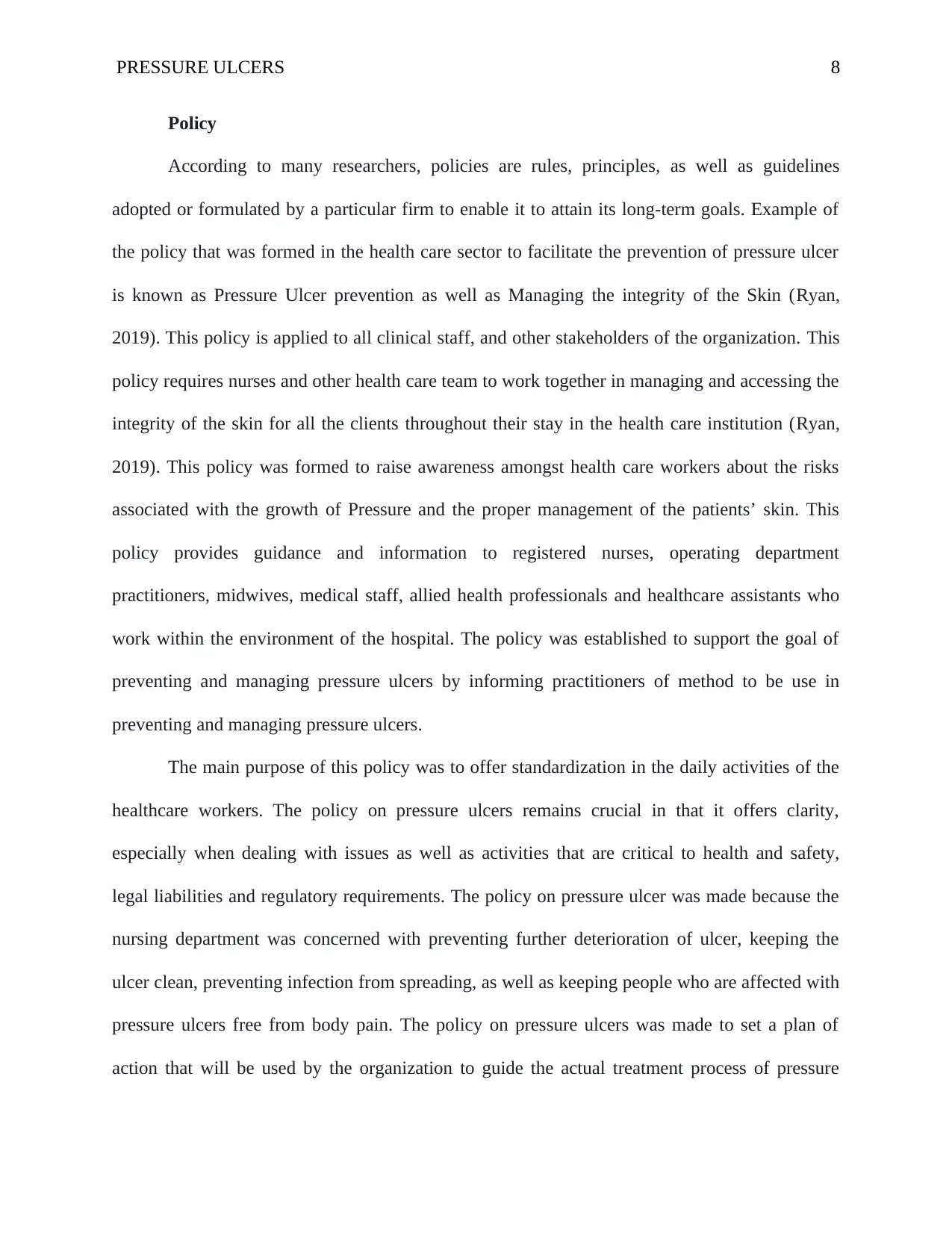
PRESSURE ULCERS 8
Policy
According to many researchers, policies are rules, principles, as well as guidelines
adopted or formulated by a particular firm to enable it to attain its long-term goals. Example of
the policy that was formed in the health care sector to facilitate the prevention of pressure ulcer
is known as Pressure Ulcer prevention as well as Managing the integrity of the Skin (Ryan,
2019). This policy is applied to all clinical staff, and other stakeholders of the organization. This
policy requires nurses and other health care team to work together in managing and accessing the
integrity of the skin for all the clients throughout their stay in the health care institution (Ryan,
2019). This policy was formed to raise awareness amongst health care workers about the risks
associated with the growth of Pressure and the proper management of the patients’ skin. This
policy provides guidance and information to registered nurses, operating department
practitioners, midwives, medical staff, allied health professionals and healthcare assistants who
work within the environment of the hospital. The policy was established to support the goal of
preventing and managing pressure ulcers by informing practitioners of method to be use in
preventing and managing pressure ulcers.
The main purpose of this policy was to offer standardization in the daily activities of the
healthcare workers. The policy on pressure ulcers remains crucial in that it offers clarity,
especially when dealing with issues as well as activities that are critical to health and safety,
legal liabilities and regulatory requirements. The policy on pressure ulcer was made because the
nursing department was concerned with preventing further deterioration of ulcer, keeping the
ulcer clean, preventing infection from spreading, as well as keeping people who are affected with
pressure ulcers free from body pain. The policy on pressure ulcers was made to set a plan of
action that will be used by the organization to guide the actual treatment process of pressure
Policy
According to many researchers, policies are rules, principles, as well as guidelines
adopted or formulated by a particular firm to enable it to attain its long-term goals. Example of
the policy that was formed in the health care sector to facilitate the prevention of pressure ulcer
is known as Pressure Ulcer prevention as well as Managing the integrity of the Skin (Ryan,
2019). This policy is applied to all clinical staff, and other stakeholders of the organization. This
policy requires nurses and other health care team to work together in managing and accessing the
integrity of the skin for all the clients throughout their stay in the health care institution (Ryan,
2019). This policy was formed to raise awareness amongst health care workers about the risks
associated with the growth of Pressure and the proper management of the patients’ skin. This
policy provides guidance and information to registered nurses, operating department
practitioners, midwives, medical staff, allied health professionals and healthcare assistants who
work within the environment of the hospital. The policy was established to support the goal of
preventing and managing pressure ulcers by informing practitioners of method to be use in
preventing and managing pressure ulcers.
The main purpose of this policy was to offer standardization in the daily activities of the
healthcare workers. The policy on pressure ulcers remains crucial in that it offers clarity,
especially when dealing with issues as well as activities that are critical to health and safety,
legal liabilities and regulatory requirements. The policy on pressure ulcer was made because the
nursing department was concerned with preventing further deterioration of ulcer, keeping the
ulcer clean, preventing infection from spreading, as well as keeping people who are affected with
pressure ulcers free from body pain. The policy on pressure ulcers was made to set a plan of
action that will be used by the organization to guide the actual treatment process of pressure
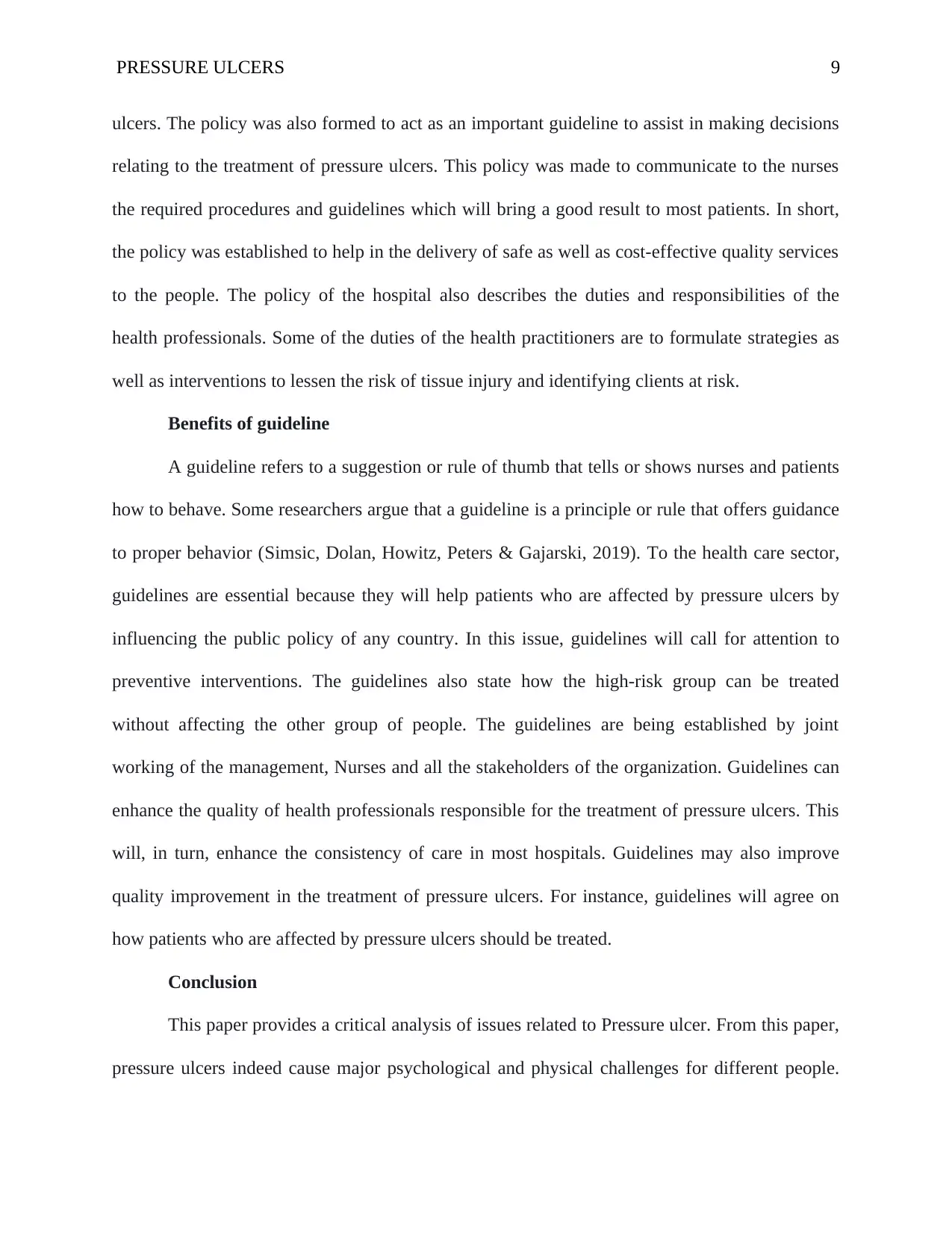
PRESSURE ULCERS 9
ulcers. The policy was also formed to act as an important guideline to assist in making decisions
relating to the treatment of pressure ulcers. This policy was made to communicate to the nurses
the required procedures and guidelines which will bring a good result to most patients. In short,
the policy was established to help in the delivery of safe as well as cost-effective quality services
to the people. The policy of the hospital also describes the duties and responsibilities of the
health professionals. Some of the duties of the health practitioners are to formulate strategies as
well as interventions to lessen the risk of tissue injury and identifying clients at risk.
Benefits of guideline
A guideline refers to a suggestion or rule of thumb that tells or shows nurses and patients
how to behave. Some researchers argue that a guideline is a principle or rule that offers guidance
to proper behavior (Simsic, Dolan, Howitz, Peters & Gajarski, 2019). To the health care sector,
guidelines are essential because they will help patients who are affected by pressure ulcers by
influencing the public policy of any country. In this issue, guidelines will call for attention to
preventive interventions. The guidelines also state how the high-risk group can be treated
without affecting the other group of people. The guidelines are being established by joint
working of the management, Nurses and all the stakeholders of the organization. Guidelines can
enhance the quality of health professionals responsible for the treatment of pressure ulcers. This
will, in turn, enhance the consistency of care in most hospitals. Guidelines may also improve
quality improvement in the treatment of pressure ulcers. For instance, guidelines will agree on
how patients who are affected by pressure ulcers should be treated.
Conclusion
This paper provides a critical analysis of issues related to Pressure ulcer. From this paper,
pressure ulcers indeed cause major psychological and physical challenges for different people.
ulcers. The policy was also formed to act as an important guideline to assist in making decisions
relating to the treatment of pressure ulcers. This policy was made to communicate to the nurses
the required procedures and guidelines which will bring a good result to most patients. In short,
the policy was established to help in the delivery of safe as well as cost-effective quality services
to the people. The policy of the hospital also describes the duties and responsibilities of the
health professionals. Some of the duties of the health practitioners are to formulate strategies as
well as interventions to lessen the risk of tissue injury and identifying clients at risk.
Benefits of guideline
A guideline refers to a suggestion or rule of thumb that tells or shows nurses and patients
how to behave. Some researchers argue that a guideline is a principle or rule that offers guidance
to proper behavior (Simsic, Dolan, Howitz, Peters & Gajarski, 2019). To the health care sector,
guidelines are essential because they will help patients who are affected by pressure ulcers by
influencing the public policy of any country. In this issue, guidelines will call for attention to
preventive interventions. The guidelines also state how the high-risk group can be treated
without affecting the other group of people. The guidelines are being established by joint
working of the management, Nurses and all the stakeholders of the organization. Guidelines can
enhance the quality of health professionals responsible for the treatment of pressure ulcers. This
will, in turn, enhance the consistency of care in most hospitals. Guidelines may also improve
quality improvement in the treatment of pressure ulcers. For instance, guidelines will agree on
how patients who are affected by pressure ulcers should be treated.
Conclusion
This paper provides a critical analysis of issues related to Pressure ulcer. From this paper,
pressure ulcers indeed cause major psychological and physical challenges for different people.
⊘ This is a preview!⊘
Do you want full access?
Subscribe today to unlock all pages.

Trusted by 1+ million students worldwide
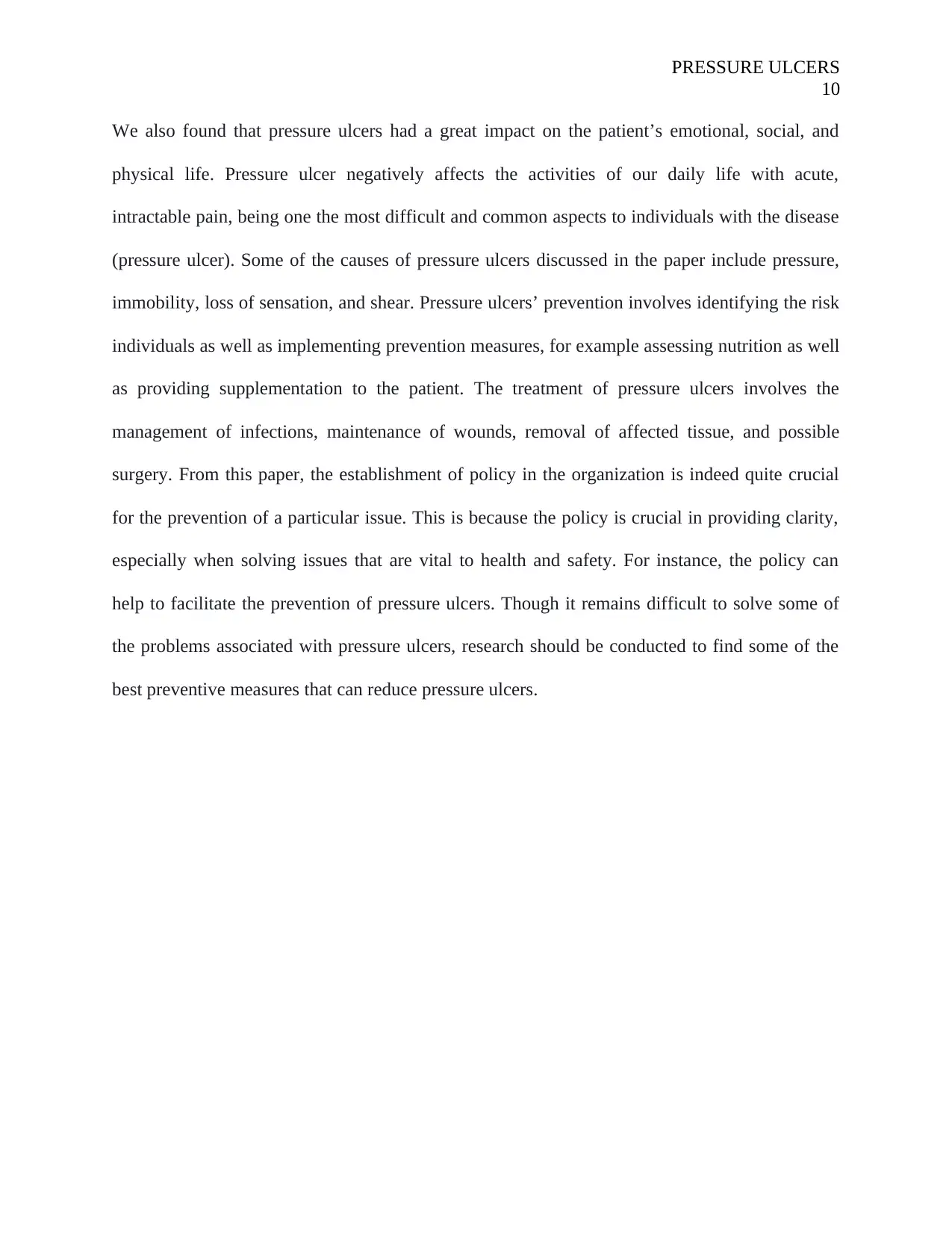
PRESSURE ULCERS
10
We also found that pressure ulcers had a great impact on the patient’s emotional, social, and
physical life. Pressure ulcer negatively affects the activities of our daily life with acute,
intractable pain, being one the most difficult and common aspects to individuals with the disease
(pressure ulcer). Some of the causes of pressure ulcers discussed in the paper include pressure,
immobility, loss of sensation, and shear. Pressure ulcers’ prevention involves identifying the risk
individuals as well as implementing prevention measures, for example assessing nutrition as well
as providing supplementation to the patient. The treatment of pressure ulcers involves the
management of infections, maintenance of wounds, removal of affected tissue, and possible
surgery. From this paper, the establishment of policy in the organization is indeed quite crucial
for the prevention of a particular issue. This is because the policy is crucial in providing clarity,
especially when solving issues that are vital to health and safety. For instance, the policy can
help to facilitate the prevention of pressure ulcers. Though it remains difficult to solve some of
the problems associated with pressure ulcers, research should be conducted to find some of the
best preventive measures that can reduce pressure ulcers.
10
We also found that pressure ulcers had a great impact on the patient’s emotional, social, and
physical life. Pressure ulcer negatively affects the activities of our daily life with acute,
intractable pain, being one the most difficult and common aspects to individuals with the disease
(pressure ulcer). Some of the causes of pressure ulcers discussed in the paper include pressure,
immobility, loss of sensation, and shear. Pressure ulcers’ prevention involves identifying the risk
individuals as well as implementing prevention measures, for example assessing nutrition as well
as providing supplementation to the patient. The treatment of pressure ulcers involves the
management of infections, maintenance of wounds, removal of affected tissue, and possible
surgery. From this paper, the establishment of policy in the organization is indeed quite crucial
for the prevention of a particular issue. This is because the policy is crucial in providing clarity,
especially when solving issues that are vital to health and safety. For instance, the policy can
help to facilitate the prevention of pressure ulcers. Though it remains difficult to solve some of
the problems associated with pressure ulcers, research should be conducted to find some of the
best preventive measures that can reduce pressure ulcers.
Paraphrase This Document
Need a fresh take? Get an instant paraphrase of this document with our AI Paraphraser
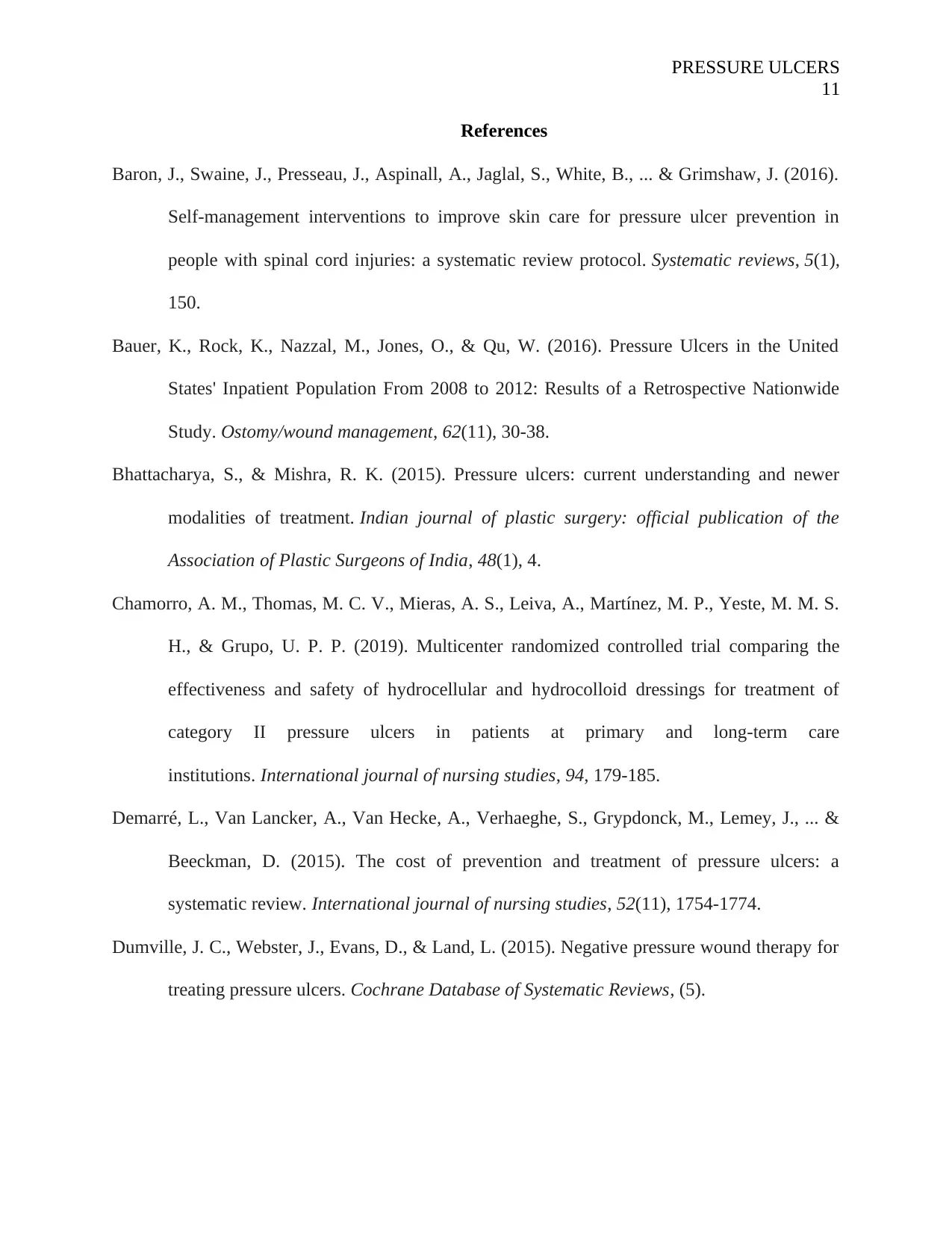
PRESSURE ULCERS
11
References
Baron, J., Swaine, J., Presseau, J., Aspinall, A., Jaglal, S., White, B., ... & Grimshaw, J. (2016).
Self-management interventions to improve skin care for pressure ulcer prevention in
people with spinal cord injuries: a systematic review protocol. Systematic reviews, 5(1),
150.
Bauer, K., Rock, K., Nazzal, M., Jones, O., & Qu, W. (2016). Pressure Ulcers in the United
States' Inpatient Population From 2008 to 2012: Results of a Retrospective Nationwide
Study. Ostomy/wound management, 62(11), 30-38.
Bhattacharya, S., & Mishra, R. K. (2015). Pressure ulcers: current understanding and newer
modalities of treatment. Indian journal of plastic surgery: official publication of the
Association of Plastic Surgeons of India, 48(1), 4.
Chamorro, A. M., Thomas, M. C. V., Mieras, A. S., Leiva, A., Martínez, M. P., Yeste, M. M. S.
H., & Grupo, U. P. P. (2019). Multicenter randomized controlled trial comparing the
effectiveness and safety of hydrocellular and hydrocolloid dressings for treatment of
category II pressure ulcers in patients at primary and long-term care
institutions. International journal of nursing studies, 94, 179-185.
Demarré, L., Van Lancker, A., Van Hecke, A., Verhaeghe, S., Grypdonck, M., Lemey, J., ... &
Beeckman, D. (2015). The cost of prevention and treatment of pressure ulcers: a
systematic review. International journal of nursing studies, 52(11), 1754-1774.
Dumville, J. C., Webster, J., Evans, D., & Land, L. (2015). Negative pressure wound therapy for
treating pressure ulcers. Cochrane Database of Systematic Reviews, (5).
11
References
Baron, J., Swaine, J., Presseau, J., Aspinall, A., Jaglal, S., White, B., ... & Grimshaw, J. (2016).
Self-management interventions to improve skin care for pressure ulcer prevention in
people with spinal cord injuries: a systematic review protocol. Systematic reviews, 5(1),
150.
Bauer, K., Rock, K., Nazzal, M., Jones, O., & Qu, W. (2016). Pressure Ulcers in the United
States' Inpatient Population From 2008 to 2012: Results of a Retrospective Nationwide
Study. Ostomy/wound management, 62(11), 30-38.
Bhattacharya, S., & Mishra, R. K. (2015). Pressure ulcers: current understanding and newer
modalities of treatment. Indian journal of plastic surgery: official publication of the
Association of Plastic Surgeons of India, 48(1), 4.
Chamorro, A. M., Thomas, M. C. V., Mieras, A. S., Leiva, A., Martínez, M. P., Yeste, M. M. S.
H., & Grupo, U. P. P. (2019). Multicenter randomized controlled trial comparing the
effectiveness and safety of hydrocellular and hydrocolloid dressings for treatment of
category II pressure ulcers in patients at primary and long-term care
institutions. International journal of nursing studies, 94, 179-185.
Demarré, L., Van Lancker, A., Van Hecke, A., Verhaeghe, S., Grypdonck, M., Lemey, J., ... &
Beeckman, D. (2015). The cost of prevention and treatment of pressure ulcers: a
systematic review. International journal of nursing studies, 52(11), 1754-1774.
Dumville, J. C., Webster, J., Evans, D., & Land, L. (2015). Negative pressure wound therapy for
treating pressure ulcers. Cochrane Database of Systematic Reviews, (5).
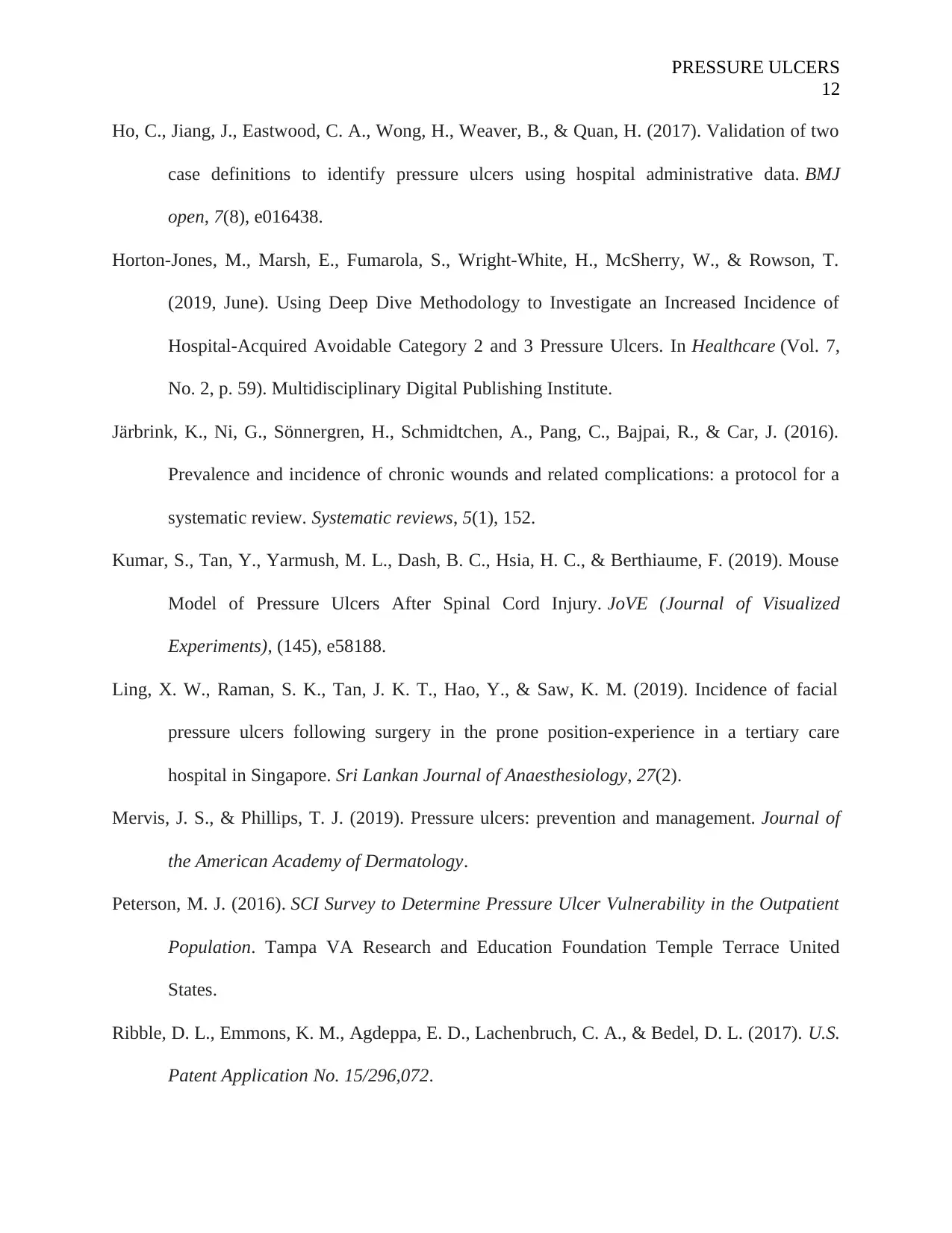
PRESSURE ULCERS
12
Ho, C., Jiang, J., Eastwood, C. A., Wong, H., Weaver, B., & Quan, H. (2017). Validation of two
case definitions to identify pressure ulcers using hospital administrative data. BMJ
open, 7(8), e016438.
Horton-Jones, M., Marsh, E., Fumarola, S., Wright-White, H., McSherry, W., & Rowson, T.
(2019, June). Using Deep Dive Methodology to Investigate an Increased Incidence of
Hospital-Acquired Avoidable Category 2 and 3 Pressure Ulcers. In Healthcare (Vol. 7,
No. 2, p. 59). Multidisciplinary Digital Publishing Institute.
Järbrink, K., Ni, G., Sönnergren, H., Schmidtchen, A., Pang, C., Bajpai, R., & Car, J. (2016).
Prevalence and incidence of chronic wounds and related complications: a protocol for a
systematic review. Systematic reviews, 5(1), 152.
Kumar, S., Tan, Y., Yarmush, M. L., Dash, B. C., Hsia, H. C., & Berthiaume, F. (2019). Mouse
Model of Pressure Ulcers After Spinal Cord Injury. JoVE (Journal of Visualized
Experiments), (145), e58188.
Ling, X. W., Raman, S. K., Tan, J. K. T., Hao, Y., & Saw, K. M. (2019). Incidence of facial
pressure ulcers following surgery in the prone position-experience in a tertiary care
hospital in Singapore. Sri Lankan Journal of Anaesthesiology, 27(2).
Mervis, J. S., & Phillips, T. J. (2019). Pressure ulcers: prevention and management. Journal of
the American Academy of Dermatology.
Peterson, M. J. (2016). SCI Survey to Determine Pressure Ulcer Vulnerability in the Outpatient
Population. Tampa VA Research and Education Foundation Temple Terrace United
States.
Ribble, D. L., Emmons, K. M., Agdeppa, E. D., Lachenbruch, C. A., & Bedel, D. L. (2017). U.S.
Patent Application No. 15/296,072.
12
Ho, C., Jiang, J., Eastwood, C. A., Wong, H., Weaver, B., & Quan, H. (2017). Validation of two
case definitions to identify pressure ulcers using hospital administrative data. BMJ
open, 7(8), e016438.
Horton-Jones, M., Marsh, E., Fumarola, S., Wright-White, H., McSherry, W., & Rowson, T.
(2019, June). Using Deep Dive Methodology to Investigate an Increased Incidence of
Hospital-Acquired Avoidable Category 2 and 3 Pressure Ulcers. In Healthcare (Vol. 7,
No. 2, p. 59). Multidisciplinary Digital Publishing Institute.
Järbrink, K., Ni, G., Sönnergren, H., Schmidtchen, A., Pang, C., Bajpai, R., & Car, J. (2016).
Prevalence and incidence of chronic wounds and related complications: a protocol for a
systematic review. Systematic reviews, 5(1), 152.
Kumar, S., Tan, Y., Yarmush, M. L., Dash, B. C., Hsia, H. C., & Berthiaume, F. (2019). Mouse
Model of Pressure Ulcers After Spinal Cord Injury. JoVE (Journal of Visualized
Experiments), (145), e58188.
Ling, X. W., Raman, S. K., Tan, J. K. T., Hao, Y., & Saw, K. M. (2019). Incidence of facial
pressure ulcers following surgery in the prone position-experience in a tertiary care
hospital in Singapore. Sri Lankan Journal of Anaesthesiology, 27(2).
Mervis, J. S., & Phillips, T. J. (2019). Pressure ulcers: prevention and management. Journal of
the American Academy of Dermatology.
Peterson, M. J. (2016). SCI Survey to Determine Pressure Ulcer Vulnerability in the Outpatient
Population. Tampa VA Research and Education Foundation Temple Terrace United
States.
Ribble, D. L., Emmons, K. M., Agdeppa, E. D., Lachenbruch, C. A., & Bedel, D. L. (2017). U.S.
Patent Application No. 15/296,072.
⊘ This is a preview!⊘
Do you want full access?
Subscribe today to unlock all pages.

Trusted by 1+ million students worldwide
1 out of 13
Related Documents
Your All-in-One AI-Powered Toolkit for Academic Success.
+13062052269
info@desklib.com
Available 24*7 on WhatsApp / Email
![[object Object]](/_next/static/media/star-bottom.7253800d.svg)
Unlock your academic potential
Copyright © 2020–2025 A2Z Services. All Rights Reserved. Developed and managed by ZUCOL.





